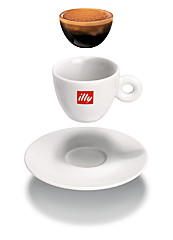A Winning Formula for Traditional Espresso: Part

At the center of my 20-plus years of training and knowledge is illycaff è. Certainly my views on coffee have been influenced by the company's scientific environment, created by three generations of chemists; a research and development unit covering agronomy, botany, physics, chemistry, biology, statistics, and computer science; and laboratories dedicated to the study of coffee, in areas like sensory perception (not just taste, but aroma as well).
Coffee is intricate and requires education and passion to get right--plus a lot of practice. Espresso is the most complex coffee preparation, containing around 1500 chemical substances, of which 800 are volatile. There are also more than 100 chemical/physical variables that affect the final preparation-like water composition, the size and distribution of the ground coffee particles, filter dimensions and hole diameter, dynamic water flow temperature and pressure, shape and temperature of the cup, roasting degree, and many, many more... I can go on for pages and pages.
The potential aromatic components and flavors are crucial, because their presence in the cup is determined not only by which coffee we choose to prepare the espresso but also by the preparation method. A single little mistake can affect the final result. Thanks to the crema, the taste of espresso lingers on the tongue for up to 30 minutes and should be a pleasure to hold with you from cup to cup.
In my native Italian, espresso means "express," or prepared at the moment of serving. Interpreting the word literally, all coffee drinks prepared and drunk "on demand" with an espresso machine, using any formula, can technically be called espresso. But espresso's brewing formula isn't something you can play with radically. Dramatically altering its widely accepted "recipe" produces an entirely different end result. The Specialty Coffee Association of America, the leading trade authority, defines espresso's recipe as:
A 25-35ml (.85-1.2ounce) beverage prepared from 7-9 grams (14-18 grams for double) of coffee through which clean water of 195205 F degree has been forced at 9-10 atmospheric of pressure and where the grind of the coffee is such that the brew time is 20-30 seconds.
For a double espresso, the formula calls for using twice the amount of coffee and twice the water. If the water isn't increased in proportion, the resulting extraction will have too little liquid and too much crema. The beverage is too concentrated, its aromatic components not optimally released and mixed. Effectively, the aromas overlap with one another, creating issues like an extremely sour taste that can be perceived as salty. With this overconcentration, only a few pleasurable notes can emerge in the cup, masking others produced during roasting like chocolate, toasted bread, cocoa, and caramel. Lost is that ideal balance of bitter and sour.
But some baristas prefer making double espressos with more than twice the amount of coffee--20 grams, not the 14-18 the SCAA guidelines would suggest--and only the amount of water for a single espresso, one ounce. The idea is a power-packed espresso, with half the one ounce of extraction being crema. It might sound good to espresso fans, but this idea has numerous problems.
No matter what you call this concentrate, the caffeine content is much higher than what we have come to expect with a traditional espresso. For years people thought espresso contained more caffeine than brewed coffee. Now, most professionals and coffee lovers know this is not true of Arabica espresso prepared with the traditional formula, which contains 60 to 70 milligrams of caffeine. Overdosing the espresso, even using Arabica beans and not higher-caffeine Robusta, the caffeine content could reach 200 milligrams. As logic would dictate, extraction time--how long coffee and water remain in contact--is a major factor. At the highest levels, a 16-ounce brewed coffee often contains more than 300 milligrams. To compare, Coca-Cola Classic has 35 milligrams per 12 ounces and Red Bull has 80 milligrams per 8.3 ounces. So if it's just caffeine you are after, there are lots of options. All the more reason that the taste and flavor of espresso must be enjoyable. There is so much to cover and learn about espresso, and the surface has barely been scratched. Along with milk, I plan to talk about roasting-the Maillard reaction as it relates to over-roasted coffee, single-origin coffees (which I enjoy too), and degassing (letting freshly roasted coffee properly mature before using). Check back often for more discussions!
Important Notice :
前街咖啡 FrontStreet Coffee has moved to new addredd:
FrontStreet Coffee Address: 315,Donghua East Road,GuangZhou
Tel:020 38364473
- Prev

Espresso on Scales-CoffeeGeek
Photo:showing the final shot. My starting dose was 19.2g so finishing at 27.4g gives me 1.42 ratio on coffee weight to brew weight. My target is usually in the 1.25-1.5 range (depending on taste). Really had to get creative with the light
- Next

Discussion on the production Standard of espresso
Question by Alketa, Jan. 16, 2012 4:07 PM Hello Mr. Michele. I have a question regarding the extraction time for the espresso coffee. I have read that the exact time is 25-30 sec, but recently i heard that is 15 sec. Could you please expla
Related
- How did the Salvadoran coffee industry develop in Central America?
- What exactly does the golden cup extraction of coffee mean?
- The Origin of Coffee flower
- [2023 Starbucks World Earth Day] there are more meaningful things besides free Starbucks coffee!
- What kind of coffee is there in Spain? 9 Flavors of Spanish Coffee
- Aromatic African coffee| Kenya's coffee culture and historical production area
- Liberica Coffee Bean knowledge: the characteristics of Liberian Coffee beans of the three original species of Coffee beans
- The origin and formula of Spanish latte introduces the taste characteristics of Bombon coffee in Valencia, Spain.
- How to adjust the solution of over-extracted coffee
- What is the tasting period of coffee beans? What is the period of coffee and beans? How should coffee wake up and raise beans?

